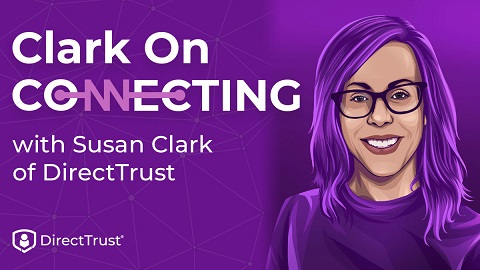 Susan Clark, Senior Director of Program Development, DirectTrust
Susan Clark, Senior Director of Program Development, DirectTrust
LinkedIn: Susan Houck Clark
You may have seen my recent appearance on a webcast discussing justice-involved individuals and their coordination of care and wondered, “Why would someone who has never worked in the justice system have insights on this topic?” Let’s jump in my way-back machine to explore the origin.
Beginning in 2010, I worked at Purdue University as part of the Regional Extension Center at the dawn of Meaningful Use (now Promoting Interoperability), where we partnered with the developing health information exchanges in the states, assisting in getting awareness and education to their services. (We’ll come back to this.)
Following my time at Purdue, I worked for a consulting company focusing on quality programs and EHR optimization. We had an opportunity to partner on a proposal with an organization that provides full-service healthcare provisions to correctional facilities. Having spent much of my life in more traditional clinics and hospitals, I was not tuned in to this whole other universe of care sites. However, if care is being delivered, they should have equal access to information. As it turned out, they were completely under-resourced in health technology professionals and did not prioritize modernizing their EHR and health data. I was already aware of inequities in long-term care and behavioral health technology, but now this gave me a whole new quest to champion and bring justice to the health IT multiverse. (Yes, I know what I just did there.)
Fast forward a few years. While serving as a contractor with the State Health IT Coordinator within Indiana Family and Social Services Administration, I had reconnected with my contact from Michiana Health Information Network (now part of Indiana Health Information Exchange (IHIE)), whom I knew from my Purdue days, as part of a statewide health IT environmental scan. We continued to keep in contact as I was a conduit for them to the State Health IT Coordinator, where I was receiving a mega crash course in understanding how a greater ecosystem of health IT can be funded through CMS Medicaid Technology. My MHIN friend invited me to a meeting that included IHIE and the Indiana Department of Correction to discuss how HIE could address information gaps in quality and coordination of care. It was in this meeting that I was wholly inspired by the chief medical officer and learned about the re-entry program and the significantly poor outcomes that occur in the absence of a proper handoff to the community. With only a couple of years remaining in the HITECH funding window, I brought the use case and budgets back to the FSSA technology team.
At the time, those in the justice system did not have Medicaid benefits UNTIL they were released. However, then the Medicaid managed care organizations assumed accountability for these persons. It was also around this time that I happened upon an article from one of those health plans contracted in Indiana who had put a conscious investment into re-entry programs. I took it upon myself to reach out to the physician executive mentioned in the article who also served as the chief equity officer because I wanted to know more about these programs and how we can serve them in the state. She was more than happy to have the conversation, where I also included the state HIT coordinator to additionally inform the funding request. And we indeed were able to get approved for that work. Unfortunately, the connections were not able to be made to the extent desired in the funding timeframe due to the same issues I mentioned earlier regarding this agency and their contractors being very limited in health technology infrastructure and resources. That is what has fueled me to carry this torch and continue to evangelize that acute care hospitals cannot alone solve for a healthy population, so they cannot be the only ones with modern technology capabilities and resources. And just by being passionate about it, it has been recognized to be talked about in our health tech media and enabling those of us who care about it to find each other. The takeaway here is that you don’t have to be an expert in a field to facilitate a movement, which I am able to do by living by the #HealthITRockStar principles I outlined in the inaugural issue of this series. I would like to highlight which of those principles were present in this month’s real-life example:
- Possess a desire to serve the greater good.
- Stay curious, my friend.
- Introduce yourself.
- Maintain an expansive outlook.
Stay tuned for next month’s episode where I could have an intertwining story that includes cats, opioids, cool socks, brown M&Ms, bourbon, or starting over in a new state. And, of course, health information technology!

